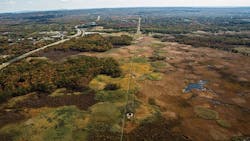PPL Energizes Susquehanna-Roseland Transmission Line
PPL Electric Utilities energized the Susquehanna-Roseland transmission line on May 11, completing a major upgrade to the nation's electric grid.
The new 500-kV power line will make electric service more reliable for millions of people in the Northeast. The three-year construction project created significant economic benefits in Pennsylvania and New Jersey, including 2,000 construction jobs. It also enables savings for electric customers by reducing transmission congestion charges.
"Building a major transmission line takes expertise in construction and project management, but it also involves knowing how to seek and incorporate public input, how to work cooperatively with multiple permitting agencies, and how to minimize impacts on people and the environment," said Stephanie Raymond, PPL's vice president-Transmission and Substations. "Susquehanna-Roseland will serve as the model as we plan future transmission projects to benefit consumers."
The PJM Interconnection, the regional grid operator, determined that Susquehanna-Roseland was needed to improve reliability by relieving congestion on other regional transmission lines. PPL built the 101-mile Pennsylvania portion and Public Service Electric and Gas Company constructed the 45 miles in New Jersey. The two companies partnered to build a four-mile segment through National Park Service lands on the border of the two states.
As part of its efforts to minimize impacts, PPL located the line on an existing transmission right of way for more than 90 percent of the Pennsylvania route. The company worked successfully with local, state and federal agencies to obtain the required environmental permits. PPL held 25 public open houses to solicit public input on the project and made changes where possible to minimize impacts.
Susquehanna-Roseland was one of seven projects nationwide fast-tracked by the Obama administration's Rapid Response Team for Transmission, recognizing the importance of the line to the nation's power grid and the need for streamlined and coordinated government action on the required federal permits.
The project also led to significant public benefits in the form of expanded national park lands, wetland improvements and cultural and historic preservation activities.
Restoration of the construction areas – including regrading and replanting – will continue for several months along portions of the route in Pennsylvania.
